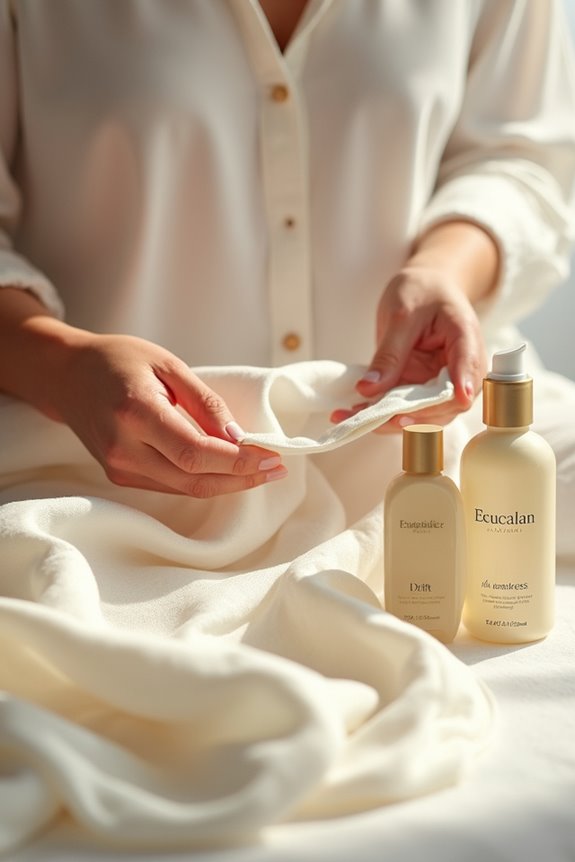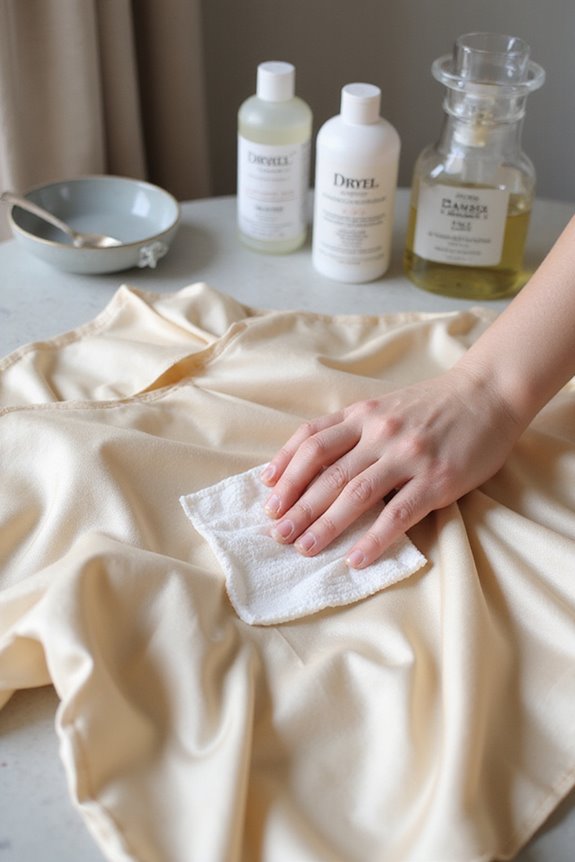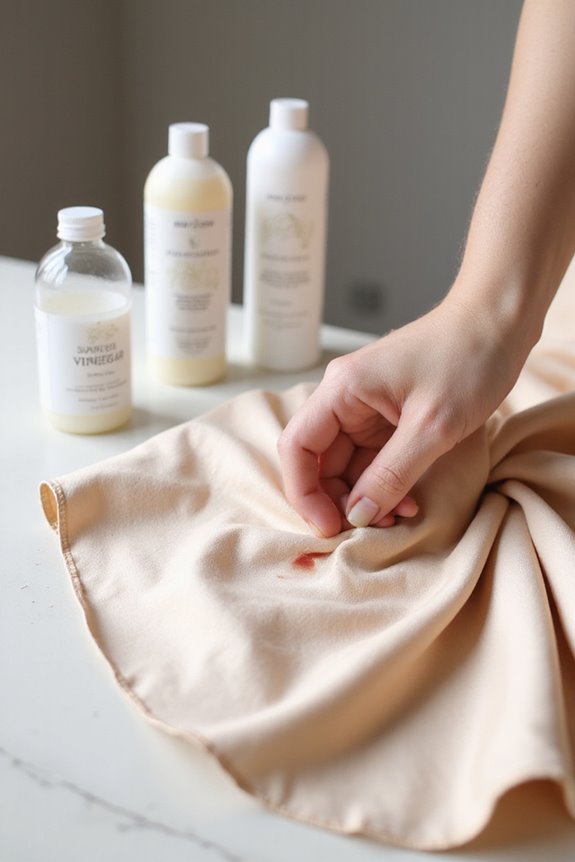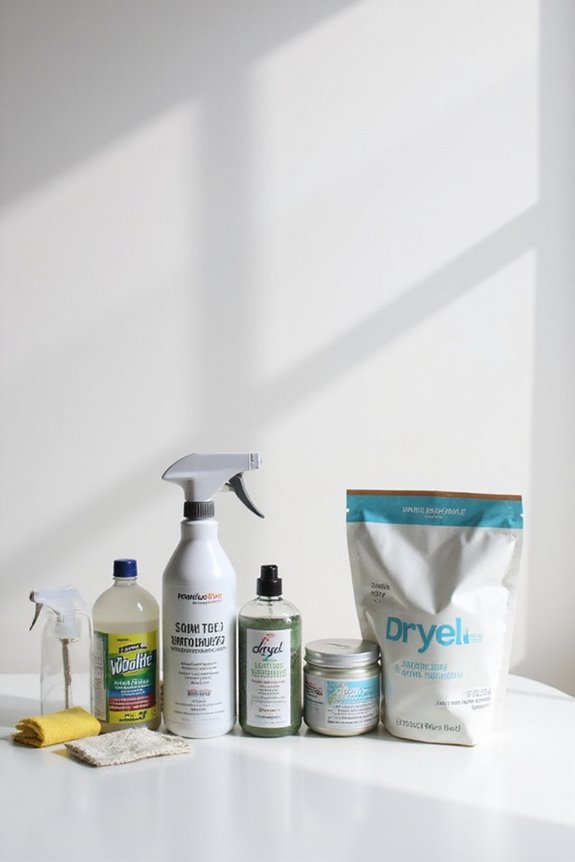When we’re tackling stains on silk, it’s key to pick gentle options. We love enzymatic stain removers; they break down protein stains without damaging the fibers. Mild detergents, like Persil Non-Bio, are safe too. If you’ve got an oil stain, cornstarch is a natural champ at absorbing it. Remember to test anything on a hidden area first—nobody likes a surprise mishap! Stick around, and we’ll share more tips for caring for your precious silk.
Key Takeaways
- Enzymatic-based stain removers are effective and safe for breaking down protein stains on silk without causing harm.
- Mild detergents like Persil Non-Bio are suitable for hand washing silk and help maintain fabric integrity.
- A mixture of white vinegar and lukewarm water can restore silk’s shine; always test on a hidden area first.
- Cornstarch or talcum powder can absorb oil stains safely without damaging silk fabric.
- Avoid harsh chemicals or bleach when selecting stain removers to preserve silk quality and appearance.
Understanding Silk and Its Sensitivities
When we think about silk, it’s easy to imagine its luxurious feel and beautiful sheen, but did you know that this fabric has some unique sensitivities we need to take into account? Silk’s properties stem from its protein structure, primarily made up of fibroin and sericin. Fibroin provides strength, while sericin offers a protective coating. However, silk’s delicate nature means it can weaken when exposed to water for too long. Its triangular cross-section gives it that smooth texture we love, but it also makes silk susceptible to damage. So, while we adore wearing it, we have to treat silk with care. Remember, it’s not just a pretty fabric; it’s a delicate masterpiece! Additionally, using a gentle wash detergent specifically formulated for delicate fabrics can help maintain silk’s quality and longevity.
Recommended Silk-Safe Stain Removers

Silk’s delicate charm calls for special care, especially when it comes to tackling stains. For effective stain removal, we recommend gentle formulations with enzyme effectiveness. Enzymatic-based stain removers, like those from Blissy Wash, break down protein stains without harming silk fibers. We’ve also found that a mix of white vinegar and lukewarm water can restore silk’s shine, but always test it first on a hidden area. Mild detergents, such as Persil Non-Bio, are perfect for hand washing, ensuring the silk remains intact. Remember, any product we choose should be free from harsh chemicals or bleach. Additionally, eco-friendly options are essential for preserving both the fabric and the environment. It’s all about treating our silks with the love and care they deserve!
Safe Application Methods for Silk Stain Removal

How can we safely tackle stains on our beloved silk without causing damage? First, we should always start with colorfastness testing on a hidden area to verify our chosen method won’t harm the fabric. For water-based stains, using a diluted mild detergent is key. We’ll apply it with gentle dabbing techniques, avoiding any rubbing that could damage the fibers. For tougher stains, a vinegar solution can work wonders, but let’s just dab it on instead of soaking the whole garment. If we face oil stains, talcum powder or cornstarch is our friend—just sprinkle it on and let it absorb. After treatment, a thorough rinse with cool water will keep our silk looking fabulous for years to come! Additionally, using a product like Puracy Stain Remover Spray can provide gentle yet effective stain removal, ensuring the integrity of your delicate silk garments.
Natural Ingredients for Silk Stain Treatment

While tackling stains on our favorite silk items might seem challenging, using natural ingredients can make the process a lot easier—and safer! We can whip up some homemade remedies using simple ingredients we probably have at home. For instance, mixing white vinegar or lemon juice with lukewarm water creates a gentle stain remover. Cornstarch is great for absorbing greasy food stains, while baking soda can lift many stains, but we need to be cautious. Always test these solutions on an inconspicuous area first. And remember, pre-treating stains quickly can help with stain prevention. So, let’s embrace these natural options and keep our silk looking fabulous—without the harsh chemicals!
Addressing Different Types of Stains on Silk

When it comes to stains on silk, we all know that different types require different approaches. For protein stain removal, like blood or eggs, we should use a gentle enzyme-based detergent. Mixing it with lukewarm water and spraying it on both sides helps break down those pesky proteins. Letting it soak for about 30 minutes works wonders! Enzyme-based products are often more effective than bleach-based removers for tackling tough stains while being safe for delicate fabrics.
Now, for grease stain treatment, think frying oil or makeup. We can pre-treat these stains with enzyme-based products, like Vanish stain remover, which is silk-safe. After that, gentle hand washing with a mild detergent is key. Remember, we want to treat stains carefully to keep our silk looking fabulous, not faded! So, let’s handle those stains like pros!
Washing and Caring for Silk After Stain Removal
After we’ve tackled those stains on our silk, it’s time to give it some proper care to keep it looking its best. First, let’s use gentle detergents specifically designed for silk. They’ll help protect those delicate fibers. Always wash in cool or lukewarm water, and we recommend hand washing over machine washing to avoid any damage.
Once washed, gently squeeze out excess water—no wringing, please! Then, it’s important to air dry. Lay the silk flat or hang it up, but steer clear of direct sunlight. Remember, no tumble dryers; they’re a silk’s worst nightmare. By following these steps, we can keep our silk looking fabulous for years to come. Additionally, using a pH-neutral detergent is essential for maintaining the integrity of silk fibers. Trust us, it’s worth the effort!
Environmental Considerations for Silk Stain Removers
Choosing the right stain remover for our beloved silk can feel a bit overwhelming, especially with all the eco-friendly options out there. Thankfully, we’ve got some fantastic eco-friendly formulations to take into account. Many stain removers use biodegradable alternatives like saponified coconut oil or baking soda, which break down naturally and won’t harm our planet.
Using gentle ingredients, like white vinegar or litsea oil, guarantees we’re not just caring for our silk but also the environment. Plus, opting for plant-based products helps reduce waterway contamination. Remember, when we pre-treat stains, we’re not only saving our silk but also cutting down on water use. Additionally, choosing products with biodegradable ingredients ensures that we are minimizing pollution and promoting sustainability. So let’s choose wisely and keep both our silk and the Earth happy!
Frequently Asked Questions
Can I Use Regular Laundry Detergent on Silk?
When it comes to laundry detergent types, we can’t throw caution to the wind with silk fabric care. Regular detergents can damage delicate fibers, so we should always choose silk-specific cleaners for best results.
How Do I Test for Colorfastness on Silk?
When testing for colorfastness on silk, we should conduct various tests like spot tests and wet rubbing tests. This guarantees effective silk care, helping us maintain its beauty while preventing unwanted color changes.
Is It Safe to Machine Wash Silk Garments?
When we accidentally tossed our washable silk blouse in the machine, we learned the importance of proper silk care. Using gentle washing techniques and cold water, we found it was safe—if done right!
What Should I Do if a Stain Persists?
If a stain persists, we should apply various stain removal techniques gently and patiently. Remember our silk care tips: repeat treatments, test for colorfastness, and consider professional cleaning if home methods don’t work.
Can I Use Fabric Softener on Silk?
Using fabric softener on silk is like pouring sand on a fine painting; it ruins the beauty. For ideal silk care and fabric maintenance, let’s skip the softeners and choose gentler alternatives instead.






